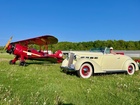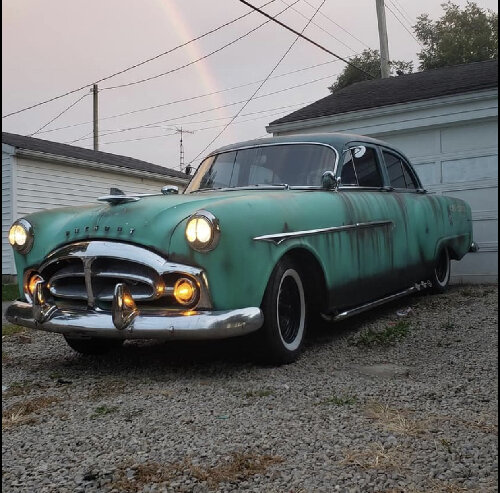|
Re: 1950 Packard
|
||||
|---|---|---|---|---|
|
Home away from home

|
Welcome!!!
Send some pictures.
Posted on: 2015/11/1 17:55
|
|||
|
Bill,
Dedicated to keeping the man who owns one on the road!!! |
||||
|
||||
|
Re: Brake Fade? What Brake Fade?
|
||||
|---|---|---|---|---|
|
Home away from home

|
Also...when doing a brake shoe replacement, the Service Manual discusses the ominous "Nibs".
I thought this was a bit of overkill however it does make a big difference in the brake shoe alignment to adjust the nibs correctly. I still dont know what a "Nib" is I do know that this procedure centers the brake shoes in the drum correctly. Essentially the anchor pin (top pin that the brake shoes are spring loaded to butt into) is not round shaped but it is actually a cam. When the "Brake Adjustment Major" procedure is followed, it instructs you to tighten the star adjuster until the wheel is "just locked" (I read barely possible to turn by hand) and then loosen the adjustment 6 clicks and now the wheel will spin with just a bit of brake drag. Then the SM tells you to loosen the anchor pin lock nut and then rotate the anchor pin until the wheel spins freely and then tighten the locking pin (making sure you do not accidentally turn the anchor pin). Then adjust as Ross recommended. This made a big deal of difference on my dads car. Prior to this it seemed that I had to loosen the star adjuster way more than the 16 clicks to keep a shoe from sliding on the drum. Also ensure your primary and secondary shoes are installed correctly so that they "self energize" correctly. I guess I don't know why they don't simply install two shoes with the longer liner so that both are the "secondary" shoe?!?!?
Posted on: 2015/11/1 17:53
|
|||
|
Bill,
Dedicated to keeping the man who owns one on the road!!! |
||||
|
||||
|
Re: engine progress pics
|
||||
|---|---|---|---|---|
|
Home away from home

|
Ohhh...pretty!!!
Had the engine ever been rebuilt? It was green prior. My dads engine was also green however it seems the original color was supposed to be grey.
Posted on: 2015/10/31 12:52
|
|||
|
Bill,
Dedicated to keeping the man who owns one on the road!!! |
||||
|
||||
|
Re: Heating issues
|
||||
|---|---|---|---|---|
|
Home away from home

|
Is the radiator cap really pressurizing the system?
Use a digital thermometer and tape the sensor to the thermostat housing and measure the temperature directly to verify that the gauge is indicating accurately (the gauge on my Packard shows uncomfortably high even when the actual water temperature is only 200F at the thermostat. I installed a six blade fan
Posted on: 2015/10/25 19:26
|
|||
|
Bill,
Dedicated to keeping the man who owns one on the road!!! |
||||
|
||||
|
Re: Heating issues
|
||||
|---|---|---|---|---|
|
Home away from home

|
Running the engine without a thermostat will not help.
A thermostat will meter the water as it flows through the radiator and thereby allow the water to remain in the radiator long enough to cool. Is the water pump gasket installed correctly? Does the water pump have serviceable vanes or are they all rusted away? Use an infrared thermometer and with the front radiator cover removed measure the temperature of the front of the radiator and all vertical rows should have the same temperature (if some rows are cold then the tubes are blocked) Try running no antifreeze for a short period of time to see if that helps. Is your electric fan blowing air the correct way or is it blowing forward?
Posted on: 2015/10/25 19:16
|
|||
|
Bill,
Dedicated to keeping the man who owns one on the road!!! |
||||
|
||||
|
Re: flywheel cover 1948
|
||||
|---|---|---|---|---|
|
Home away from home

|
The 5th bolt (bottom) is a real pain because one cannot remove the cover and inspect the clutch /throw out bearing without having to remove the rear transmission support.
Who came up with that idea!?!?!
Posted on: 2015/10/25 19:03
|
|||
|
Bill,
Dedicated to keeping the man who owns one on the road!!! |
||||
|
||||
|
Re: So Far So Good...Just a Couple More Tweaks To Go!!!
|
||||
|---|---|---|---|---|
|
Home away from home

|
THANKS (again) Ross!!!
Good information...I will investigate when I get the car again. Bill
Posted on: 2015/10/18 18:50
|
|||
|
Bill,
Dedicated to keeping the man who owns one on the road!!! |
||||
|
||||
|
So Far So Good...Just a Couple More Tweaks To Go!!!
|
||||
|---|---|---|---|---|
|
Home away from home

|
Hi All,
I just visited my dad and his Packard. He is SUPER HAPPY with the power steering and the engine/transmission run great!!! He started it up this morning and the engine purred like a kitten after about 2 turns of the crank with the starter motor...the choke clicked into position and the engine did not miss a lick to/from breakfast. The only minor tweaking needed now are the following: 1. The brake lights will occasionally stay illuminated after driving. Since the switch is a pressure switch my first thought was that there was internal pressure in the master cylinder after the engine heated up the brake fluid and it would expand. I checked the vent in the cap and it works great so that is not the problem. Since the issue is intermittent (seems to be based on temperature as cold morning it happens less) I am wondering if anyone has any suggestions. I assume the R&R procedure involves unscrewing the switch and installing the new switch and bleeding the brakes. 2. Overdrive. As mentioned above, the engine starts up right away and the choke seems to be adjusted fine because the engine purrs REALLY nice at a slightly high idle and does not pop or sputter. The choke will open and reduce the high idle as advertised as the engine warms up. He indicated that when the engine is cold the overdrive will not engage however it will always engage after the engine is warmed up. I cannot see how the OD would be affected by the choke high idle because the throttle linkage is not affected by the choke high idle cam. 3. Wide Open Throttle misfire. When the transmission is out of OD (direct drive) and the throttle pedal is pressed firmly to the floor the engine will sputter however if the throttle pedal is raised off of the floor ever so slightly the engine runs great. I cannot imagine this issue would be because of a fuel delivery problem because wide open throttle verses 97 percent of wide open throttle would not be that big of a deal. He would never notice this because I doubt he will ever floor it except to downshift out of OD. 4. Fluid leaks. The only fluid leaks under the car as noticed when I laid down next to the car and looked underneath and looked at the concrete of his favorite parking spot is a couple of drips from the oil pan drain (it does have the copper gasket and I tightened the bolt down snug...not too tight), some minor droplets from the transmission (cannot tell from where) and the rear axle pinion seal (dang...that is a new seal). 5. Power steering works mostly good. Low speed turning at tight turning (parking) still has a hum and it seems that the assist is not as strong as I would like (slight pulsating sound and feel in the steering wheel). If he ever lets me take the car away from him again (last time I kept it for 5 months) I will try to add a couple of washers to the Flow Control Valve spring to see if I can hot rod the pump a bit since the original pump has the output specs more suited for the Bendix actuator and I am running the Monroe actuator and it needs some more Ommppphhh. I did add three washers to the Pressure Valve and bumped it up from 650 PSI to 1000 PSI and that did help however I guess (hoping in vain) that the humming noise is from the FCV limiting flow to the actuator and therefore that is causing the pulsating feel/noise. 6. Rear axle noise. He does notice this one. There is a "Whoom...whoom...whoom" noise from the rear axle that increases in frequency with an increase in speed. Does not seem to be a function of throttle, steady state, or coast nor does the noise change with side loads when turning left or right. The only thing I can think is that it would be coming from the pinion nut adjustment because I had the pinion nut off to replace the rear pinion seal and lost it's marks when reinstalling. Anyhoo...That is my report. Still...running Packard + Power Steering = Happy dad!!! THANKS AGAIN!!! Bill
Posted on: 2015/10/18 17:36
|
|||
|
Bill,
Dedicated to keeping the man who owns one on the road!!! |
||||
|
||||
|
Re: How to add a PCV Valve to a 1949 Packard
|
||||
|---|---|---|---|---|
|
Home away from home

|
The vertical pipe is the pipe that goes to the electromatic clutch.
Posted on: 2015/10/18 16:50
|
|||
|
Bill,
Dedicated to keeping the man who owns one on the road!!! |
||||
|
||||








